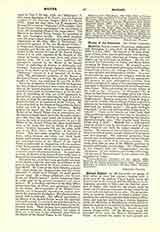

Mataco Indians (or MATAGUAYO).—A group of wild tribes of very low culture, ranging over a great part of the western Chaco region, about the head waters of the Vermejo and the Pilcomayo, in the Argentine province of Salta and the Bolivian province of Tarija, and noted for the efforts made by Jesuit and Franciscan missionaries in their behalf in the seventeenth and eighteenth centuries. The group consists, or formerly consisted, of about a dozen tribes speaking the same language with slight dialectic differences, and together constituting a distinct linguistic stock, the Matacoan or Mataguayan, which, however, Quevedo suspects to be connected with the Guaycuran stock, to which belong the Toba, Mocobf and the famous Abipon tribes. Of the Matacoan group the principal tribes were the Mataco, Mataguayo, and Vejoz. At present the names in most general use are Mataco in Argentina and Nocten (corrupted from their Chiriguano name) in Bolivia. From 60,000 (estimated) in the mission period they are now reduced to about 20,000 souls. In 1690 Father Arce, from the Jesuit college of Tarija, attempted the first mission among the Mataguayo and Chiriguano, but with little result, owing to their wandering habit. “Houses and churches were built but the natives poured in and out, like the water through a bottomless barrel”, and, at last, weary of the remonstrances of the missionaries, burned the missions, murdered several of the priests, and drove the others out of the country. At a later period, 1756, the Jesuit mission of San Ignacio de Ledesma on the Rio Grande, a southern head stream of the Vermejo, was founded for Toba and Mataguayo, of whom 600 were enrolled there at the time of the expulsion of the order in 1767.
About the end of the eighteenth century the Franciscans of Tarija undertook to restore the mission work in the Chaco, founding a number of establishments, among which were Salinas, occupied by Mataguayo and Chiriguano, and Centa (now Oran, Salta province), occupied by Mataguayo and Vejoz, the two missions in 1799 containing nearly 900 Indians, with 7300 cattle. With the decline of the Spanish power these missions also fell into decay and the Indians scattered to their forests and rivers. In 1895 Father Gionnecchini, passing by the place of the old Centa mission, found a cattle corral where the church had been. An interesting account of the present condition of the wild Mataco is quoted by Quevedo from a letter by Father Alejandro Corrado, Francis-can, Tarija. Their houses are light brush structures scattered through the forests, hardly high enough to allow of standing upright, and are abandoned for others set up in another place as often as insects or accumulation of filth make necessary. The only furniture is a wooden mortar with a few earthen pots, and some skins for sleeping. Men and women shave their heads and wear a single garment about the lower part of the body. The men also pluck out the beard and paint the face and body. They live chiefly upon fish and the fruit of the algarroba, a species of mesquit or honey-locust, but will eat anything that is not poisonous, even rats and grasshoppers. From the algarroba they prepare an intoxicating liquor which rouses them to a fighting frenzy. Their principal ceremony is in connection with the ripening of the algarroba, when the priests in fantastic dress go about the trees, dancing and singing at the top of their voices to the sound of a wooden drum, keeping up the din day and night. A somewhat similar ceremony takes place when a young girl arrives at puberty. Every-thing is in common, and a woman divides her load of fruits or roots with her neighbors without even a word of thanks. They recognize no authority, even of parents over their children. The men occupy themselves with fishing or occasional hunting, their arms being the bow and club. The women do practically all the other work.
Marriage is simple and at the will of the young people, the wife usually going to live with her husband’s relatives. Polygamy and adultery are infrequent, but divorce is easy. The woman receives little attention in pregnancy or childbirth, but on the other hand the father conforms to the couvade. Children are named when two or three years old. Abortion is very frequent; infanticide more rare, but the infant is often buried alive on the breast of the dead mother.
Disease is driven off by the medicine men with singing and shaking of rattles. They believe in a good spirit to whom they seem to pay no worship; and in a malevolent night spirit, whom they strive to propitiate. They believe that the soul, after death, enters into the body of some animal. The best work upon the language of the Mataco tribes is the grammar and dictionary of the Jesuit missionary, Father Joseph Araoz, with Quevedo’s studies of the Nocten and Vejoz dialects, from various sources.
JAMES MOONEY

